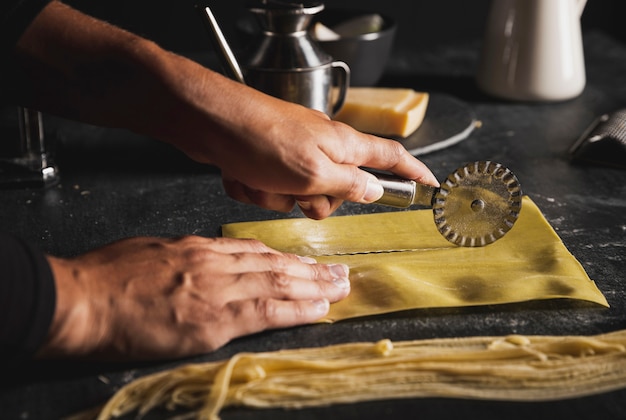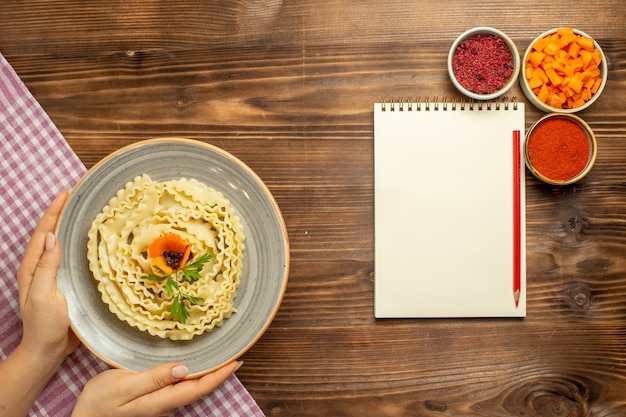Let me tell you, there's nothing quite like a perfectly cooked plate of pasta. It's a comforting classic, a blank canvas for endless flavour combinations, and a dish that always seems to hit the spot. But getting that perfect pasta, coated in a luscious sauce, isn't as simple as just throwing everything in a pot and calling it a day.
This guide is your passport to pasta perfection, leading you from the basics of choosing the right pasta and sauce to mastering the art of cooking, combining, and finishing your dish like a pro. It's a journey through the nuances of pasta, and by the end, you'll be confidently whipping up pasta dishes that would make even the most discerning Italian Nonna proud.
(Part 1) The Foundation: Understanding Pasta and Sauce

Think of this section as building the foundation of your pasta masterpiece. You wouldn't start building a house without a solid foundation, would you? Let's get those basics sorted.
1.1. Choosing the Right Pasta
You wouldn't wear a tuxedo to a picnic, would you? It's the same with pasta - each type has a personality, a purpose, a sauce it loves to dance with.
- Spaghetti: Ah, spaghetti. It's the classic long, thin strand, perfect for twirling around a fork, soaking up those chunky sauces like Bolognese or puttanesca. It's all about the twirl and the sauce clinging to every bit of that beautiful noodle.
- Penne: Short, tube-shaped pasta, with ridges that are practically begging for creamy sauces to cling to. Think Alfredo, pesto, creamy carbonara, even a rich cheese sauce. They're made for it! The ridges trap the sauce, creating a symphony of flavour in every bite.
- Rigatoni: These are the larger, more robust tubes, ideal for trapping those meaty, chunky sauces like Bolognese or a hearty ragu. They hold their own, offering a satisfying texture with every bite.
- Linguine: A little more delicate, linguine is flat, wide, and perfect for lighter, thinner sauces. Think of a simple tomato sauce or even a fresh clam sauce. It's all about the delicate touch.
1.2. Knowing Your Sauce
Now, let's talk about the sauce. You wouldn't serve a rich, creamy sauce with a simple tomato-based pasta, would you? That's just wrong! The sauce needs to complement the pasta, to be its perfect partner in crime.
- Tomato-based: Simple, versatile, these sauces are the backbone of many pasta dishes. They work beautifully with spaghetti, penne, even rigatoni. They're the friendly, approachable option, ready for any pasta adventure.
- Creamy sauces: Think Alfredo, carbonara, creamy pesto - these are the decadent, luxurious sauces, best paired with shorter pasta shapes like penne, rigatoni, or even farfalle. They need the pasta to hold onto them, to embrace their creamy richness.
- Chunky sauces: Bolognese, puttanesca, ragu - these are packed with flavour and texture, and they need a pasta shape that can handle it all. Spaghetti, linguine, or rigatoni are good choices, able to stand up to the chunky goodness.
- Oil-based: Simple, light, perfect for a lighter meal. Spaghetti, linguine, or even angel hair pasta are good choices. They're the perfect match for a light, flavourful sauce.
(Part 2) The Art of Cooking Pasta

Alright, now we're getting into the real cooking. This is where you begin to transform those raw ingredients into a delicious dish.
2.1. Boiling the Pasta
Boiling pasta seems like a simple task, right? But there's an art to it, a way to ensure you get that perfect "al dente" texture, that firm-to-the-bite goodness.
- Use plenty of water: A general rule of thumb is to use at least 6-8 cups of water for every pound of pasta. This gives the pasta space to cook evenly, to move freely, and to prevent it from sticking together.
- Salt the water: This is crucial for flavour! Adding about 1 tablespoon of salt per 4 cups of water is a good starting point. Don't be shy - a little extra salt is never a bad thing. It's the secret to adding depth of flavour to your pasta.
- Bring the water to a rolling boil: You want to hear that water singing, bubbling furiously. Don't even think about adding the pasta until it's reached a full, vigorous boil.
- Add the pasta slowly: This helps to prevent the water temperature from dropping too much, ensuring even cooking.
- Stir the pasta occasionally: This keeps it from sticking together and ensures that every strand gets a chance to cook evenly.
- Cook according to package instructions: Most pasta packages will tell you how long to cook it. Remember, al dente means firm to the bite, not crunchy. It should have a slight resistance but shouldn't be chewy.
2.2. Testing for Al Dente
Don't just rely on the package instructions. You need to be your own pasta detective, testing for that perfect "al dente" texture.
- Take a strand of pasta: Use a pair of tongs or a spoon to lift a piece of pasta out of the boiling water.
- Bite into it: It should be firm to the bite, but not crunchy. It should have a slight resistance but shouldn't be chewy.
- If it's not quite there: Cook it for another minute or two and test again.
(Part 3) The Crucial Step: The Pasta-Sauce Union

This is it, folks, the moment of truth, the point where the pasta and sauce finally meet, where the magic happens.
3.1. Timing is Key
It's all about timing, about getting that perfect marriage of pasta and sauce, ensuring they both shine.
- Reserve some pasta water: Before draining the pasta, scoop out about a cup of the pasta water using a ladle. This water is full of starch, and it's your secret weapon for thickening the sauce and adding flavour.
- Drain the pasta: Once it's cooked al dente, drain it immediately. Don't let it sit in the colander for too long, as this can cause it to become soggy.
- Add the pasta to the sauce: Do this just before you're ready to serve. This ensures that the pasta doesn't become soggy from sitting in the sauce, and it allows the sauce to coat the pasta beautifully.
3.2. The Importance of the Pasta Water
Don't underestimate the power of pasta water! This starchy liquid is your secret weapon for creating the perfect sauce, for bringing it all together.
- Adding a splash: Pour a couple of tablespoons of the reserved pasta water into the sauce. This will help to thicken it and create a creamy, luxurious texture. It adds a subtle, yet crucial, layer of flavour.
- Adding more if needed: If the sauce is too thick, add more pasta water, a tablespoon at a time, until you achieve the desired consistency.
- Remember: A little pasta water goes a long way. Start with a small amount and add more as needed.
(Part 4) The Finishing Touches: Elevating Your Pasta Dish
You've cooked the pasta perfectly, combined it with the sauce, but now it's time to take things to the next level, to add that final flourish.
4.1. Seasoning with Care
Don't forget the salt and pepper! Seasoning is key to enhancing the flavour of your pasta dish.
- Taste the sauce first: Before adding anything, taste the sauce to see if it needs any adjustments. You want to ensure the base is seasoned well, as this will be the foundation of your entire dish.
- Add salt and pepper gradually: A little goes a long way. Start with a pinch of each and taste again. Let your taste buds be your guide.
- Don't be afraid to experiment: Feel free to add other seasonings, such as garlic powder, onion powder, or even a sprinkle of red pepper flakes. Don't be afraid to get creative and add a touch of your own personality to your dish.
4.2. Adding Texture and Flavor
Sometimes, your pasta dish just needs a little something extra to truly shine.
- Fresh herbs: A sprinkle of chopped basil, parsley, or oregano can elevate your pasta dish to a whole new level. They add a vibrant touch of freshness, a burst of aromatic flavour.
- Cheese: Parmesan cheese is a classic, but don't be afraid to get creative. Try a sprinkle of Pecorino Romano, goat cheese, or even a dollop of ricotta. Each cheese brings its unique character to the table.
- Toasted bread crumbs: For a crunchy texture and nutty flavour, add a sprinkle of toasted bread crumbs. They create a delightful contrast to the smooth pasta and sauce.
- Roasted vegetables: Roasted bell peppers, onions, or mushrooms add a depth of flavour and texture. The roasting process intensifies their natural sweetness and brings out their earthy notes.
- Pancetta or bacon: For a smoky, salty flavour, add some chopped pancetta or bacon. These add a touch of indulgence and a deep, smoky aroma.
(Part 5) Serving Your Pasta Masterpiece
Alright, the pasta is cooked, the sauce is divine, and it's time to serve. But there's more to it than simply plonking it on a plate.
5.1. Presentation Matters
You've put all this effort into creating a delicious pasta dish, so don't let it down with a boring presentation.
- Use a nice plate: A plain white plate is fine, but a colourful or patterned plate can really make your pasta dish pop. It's a simple way to add a touch of elegance.
- Garnish with care: A sprinkle of fresh herbs, a dollop of cream, or a few grated cheese shavings can add a touch of elegance. A well-placed garnish is like the finishing touch on a masterpiece.
- Serve immediately: Pasta is best served hot, so don't let it sit around for too long. It's all about enjoying those flavours while they're at their peak.
5.2. Accompanying Your Pasta
Pasta is a versatile dish that can be enjoyed on its own, but it's often even better with a side dish.
- Salad: A simple salad with mixed greens, tomatoes, and a vinaigrette dressing is a classic pairing. It adds a touch of freshness and lightness to your meal.
- Garlic bread: A warm, crusty garlic bread is a perfect way to soak up the sauce. It's a delicious way to add another layer of flavour and texture.
- Roasted vegetables: Roasted vegetables, such as asparagus, broccoli, or zucchini, can add a touch of sweetness and colour. They also offer a nutritional boost to your meal.
(Part 6) Avoiding the Common Pasta Pitfalls
Even the most experienced cooks can make mistakes when it comes to pasta. Here are some common pitfalls to avoid:
6.1. Overcrowding the Pot
Adding too much pasta to the pot will lower the water temperature, preventing it from boiling properly and resulting in unevenly cooked pasta. It's best to cook the pasta in batches if you need to.
6.2. Not Stirring the Pasta
If you don't stir the pasta regularly, it will stick together and form clumps. This can make it difficult to cook evenly and will also affect the texture of the final dish. A little stir now and then ensures that every strand is getting the attention it needs.
6.3. Not Testing for Al Dente
Don't just rely on the package instructions for cooking time. Always test the pasta for al dente to ensure it's cooked perfectly. A little taste test is all it takes to ensure a delicious result.
6.4. Adding Pasta to the Sauce Too Soon
Adding pasta to the sauce too early will cause it to become soggy. It's best to add it just before serving. Patience is key!
6.5. Not Using Enough Pasta Water
Pasta water is essential for thickening the sauce and adding flavour. Don't be afraid to use a generous amount. This starchy water is a real game-changer.
(Part 7) Master Your Pasta Skills
With a bit of practice, you'll be a pasta-making pro in no time. Here are a few tips to help you master your pasta skills:
7.1. Experiment with Different Pasta Shapes
Don't be afraid to try different pasta shapes and sauces. You might discover a new favourite! There's a whole world of pasta out there, waiting to be explored.
7.2. Learn to Cook Pasta to Al Dente
This is the key to perfect pasta. Practice makes perfect. It takes a little practice, but the result is worth it.
7.3. Don't Be Afraid to Experiment with Flavors
Add different herbs, spices, and cheeses to your pasta dishes to create unique flavour combinations. Let your creativity run wild!
7.4. Use High-Quality Ingredients
The quality of your ingredients will make a big difference in the taste of your pasta dish. Splurge on good quality ingredients, and you'll be rewarded with delicious results.
7.5. Don't Overthink It
Pasta is a simple dish. Don't be afraid to relax and enjoy the process. Sometimes, the simplest recipes are the most delicious.
(Part 8) Pasta Adventures: Exploring Beyond the Basics
You've mastered the basics of cooking pasta in the sauce, but there's a whole world of pasta possibilities out there. Get creative and explore beyond the classics!
8.1. Try a New Pasta Recipe
There are countless pasta recipes out there. Pick one you've never tried before and give it a go. The world of pasta is vast, full of new flavours and textures to discover.
8.2. Experiment with Different Sauce Combinations
Combine different sauces to create unique flavour profiles. For example, try combining a creamy alfredo sauce with a tomato-based sauce for a richer flavour. There are no rules, just endless possibilities.
8.3. Make Your Own Pasta
If you're feeling adventurous, try making your own pasta from scratch. It's not as difficult as you might think! Making your own pasta is a truly rewarding experience, and it allows you to control every aspect of your dish.
8.4. Create a Pasta Dish for a Special Occasion
Make your next pasta dish a showstopper. Use high-quality ingredients and add special touches to make it unforgettable. A beautifully presented pasta dish can be the highlight of any meal.
(Part 9) FAQs: Your Pasta Questions Answered
You've got questions, I've got answers.
9.1. What if my pasta sticks together?
Don't worry, it happens to the best of us. If your pasta starts to stick together, there are a couple of things you can do. First, try stirring it more frequently. If that doesn't work, add a little more water to the pot.
9.2. How can I tell if my pasta is al dente?
The best way to tell if your pasta is al dente is to taste it. It should be firm to the bite, but not crunchy. You should be able to bite through it easily, but it shouldn't be mushy.
9.3. What if my sauce is too thick?
If your sauce is too thick, you can thin it out by adding a little pasta water or even a splash of milk or cream. A little liquid can make a big difference.
9.4. What if my sauce is too thin?
If your sauce is too thin, you can thicken it up by adding a cornstarch slurry. To make a cornstarch slurry, simply whisk together a tablespoon of cornstarch with a tablespoon of cold water. Then add it to the sauce and bring it to a boil, stirring constantly, until it thickens.
9.5. What are some good pasta dishes to make for a dinner party?
There are many great pasta dishes that are perfect for a dinner party. Here are a few ideas:
- Lasagna: This classic Italian dish is always a crowd-pleaser. It's a hearty, comforting dish that everyone enjoys.
- chicken alfredo: Creamy and rich, this dish is sure to impress your guests. It's a decadent treat that will be a hit with any crowd.
- shrimp scampi: A light and flavorful dish that is perfect for a summer dinner party. It's a refreshing and elegant choice for a warm evening.
- Pasta Carbonara: This simple, yet delicious dish is always a favourite. It's a classic that never disappoints.
- spaghetti and meatballs: A comforting classic that is sure to satisfy everyone. It's a dish that brings back memories and warms the soul.
(Part 10) The Final Word: A Delicious Journey Awaits
There you have it, folks. Your complete guide to cooking pasta in the sauce. Remember, it's all about practice and a little bit of culinary intuition. Don't be afraid to experiment, to try new things, and to most importantly, have fun! Enjoy the journey, and may your pasta be al dente and delicious!
Remember, the world of pasta is vast and waiting to be explored. So put on your apron, grab your pasta, and let the culinary adventure begin!
Everyone is watching

How to Cook Frozen Lobster Tails Perfectly: A Step-by-Step Guide
RecipesLobster. Just the word conjures up images of lavish meals, special occasions, and a taste of luxury. But let's...

Pork Fillet Cooking Time: How Long to Cook It Perfectly
RecipesPork fillet, or tenderloin as it's sometimes called, is a real favourite in our house. It's so versatile, and...

Pigs in a Blanket Cooking Time: How Long to Bake for Perfect Results
RecipesAh, pigs in a blanket. Just the name conjures up images of those delightful little parcels of crispy pastry en...

The Ultimate Guide to Cooking Delicious Frankfurters
RecipesLet's face it, we all love a good frankfurter. It's a classic, simple, and always satisfying. But let's be rea...

Wolf Meat Recipes: A Guide to Cooking Wild Game
RecipesLet's be honest, you don't see wolf meat at your local butcher shop every day. It's a bit of a wild card, but ...
